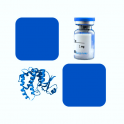
- Remove this product from my favorite's list.
- Add this product to my list of favorites.
Products
Viewed products
Newsletter
 |  |  |  |  |  |

Background
Cluster of Differentiation 31 (CD31), also known as Platelet endothelial cell adhesion molecule (PECAM-1), is a 130-kDa transmembrane glycoprotein expressed by endothelial cells, platelets, macrophages and Kupffer cells, granulocytes, T / NK cells, lymphocytes, megakaryocytes, osteoclasts, neutrophils, certain tumors, and is the only known member of the CAM family on platelets. CD31 is found on the surface of platelets, monocytes, neutrophils, and some types of T-cells, and makes up a large portion of endothelial cell intercellular junctions. The encoded protein is a member of the immunoglobulin superfamily and is likely involved in leukocyte migration, angiogenesis, and integrin activation. CD31 plays a key role in removing aged neutrophils from the body. CD31 mediates the homotypic or heterotypic cell adhesion by binding to itself or the leukocyte integrin αvβ3, and thus plays a role in neutrophil recruitment in inflammatory responses, transendothelial migration of leukocytes, as well as in cardiovascular development. In addition, it has been shown that CD31 expression is up-regulated by LPS stimulation, and might function as a feedback negative regulator of LPS inflammatory response in macrophages.
Source
Recombinant Human CD31, Fc Tag (CD1-H5258) is expressed from human 293 cells (HEK293). It contains AA Gln 28 - Lys 601 (Accession # AAH22512.1).
Predicted N-terminus: Gln 28
Molecular Characterization
This protein carries a human IgG1 Fc tag at the C-terminus.
The protein has a calculated MW of 90.6 kDa. The protein migrates as 105-130 kDa under reducing (R) condition (SDS-PAGE) due to glycosylation.
Endotoxin
Less than 1.0 EU per μg by the LAL method.
Purity
>95% as determined by SDS-PAGE.
Formulation
Lyophilized from 0.22 μm filtered solution in Tris with Glycine, Arginine and NaCl, pH7.5. Normally trehalose is added as protectant before lyophilization.
Reconstitution
See Certificate of Analysis for details of reconstitution instruction and specific concentration.
Storage
For long term storage, the product should be stored at lyophilized state at -20°C or lower.
Please avoid repeated freeze-thaw cycles.
This product is stable after storage at:
-20°C to -70°C for 12 months in lyophilized state;
-70°C for 3 months under sterile conditions after reconstitution.
(1) "Bioactive poly(salicylic acid)-poly(citric acid) scaffolds improve diabetic wound repair via regulating HIF-1α, Nrf2 and macrophage"
Xie, Ma, Luo et al
J Biomed Mater Res A (2024)
(2) "Single-cell transcriptome reveals a novel mechanism of C-Kit+-liver sinusoidal endothelial cells in NASH"
Li, Gao, Wu et al
Cell Biosci (2024) 14 (1), 31
(3) "Biomarker analysis from the phase 2b randomized placebo-controlled trial of riociguat in early diffuse cutaneous systemic sclerosis"
Khanna, Kramer, Höfler et al
Rheumatology (Oxford) (2024)
Showing 1-3 of 18408 papers.
Follow us